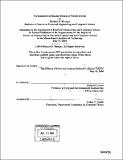Formulating earthquake response modes in Iran
Author(s)
Metzger, Michael D. (Michael David), 1981-
DownloadFull printable version (5.838Mb)
Other Contributors
Massachusetts Institute of Technology. Dept. of Electrical Engineering and Computer Science.
Advisor
Richard Larson.
Terms of use
Metadata
Show full item recordAbstract
The objective of this paper was to try and find the optimal distribution of rescuers after an earthquake with a very large magnitude caused major damage in two different cities. A model was developed to optimally divide all of the available rescuer workers such that the expected number of lives saved was maximized. When the method was tested on random sets of data on average a 5% improvement in lives saved was found. However it was also determined that there was a positive relationship between percent improvement and severity of the earthquake. This shows that the method is especially effective when extreme amounts of damage occur.
Description
Thesis (M. Eng.)--Massachusetts Institute of Technology, Dept. of Electrical Engineering and Computer Science, 2004. Includes bibliographical references (leaves 50-51).
Date issued
2004Department
Massachusetts Institute of Technology. Department of Electrical Engineering and Computer SciencePublisher
Massachusetts Institute of Technology
Keywords
Electrical Engineering and Computer Science.